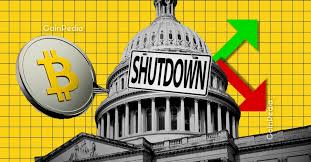After 43 days of federal lockdown, the 2025 United States federal government shutdown formally came to a close when Donald Trump signed a temporary funding bill keeping most government operations alive until January 30, 2026. (The Washington Post) The ripple effects of this political stalemate stretch far beyond politics—they’re being felt in the financial and crypto-markets, too. In this article we’ll look at how the shutdown impacted crypto, why the end of it matters, and how things might proceed from here.
What Happened in Washington
The shutdown began on October 1, 2025, when Congress failed to pass full-year funding for fiscal 2026. (Wikipedia) The Senate finally approved a continuing resolution (CR) on November 10 by a 60-40 vote, funding most agencies through January 30, 2026, and legislating full-year funding for certain departments (Agriculture, Veterans Affairs, Military Construction) through the rest of FY 26. (Congress.gov)
President Trump promptly signed the bill, ending what became the longest shutdown in U.S. history. (The Washington Post)
According to reports, key consequences of the shutdown include disruption of federal services, delays in economic data release, and liquidity stress in the broader markets. (NCSL)
The Crypto Market Took a Hit
The shutdown wasn’t just a political headline—it weighed on financial markets and the crypto space.
Liquidity and Data Impacts
• With the U.S. government largely halted, economic data such as non-farm payrolls and CPI reports were delayed or uncertain, leaving investors “flying blind”. (Business Insider)
• Analysts noted that with the government not operating, the Treasury General Account (TGA) was swollen, effectively pulling liquidity out of the market and thereby straining risk assets including crypto. (Bitget)
Crypto Reaction
• The largest cryptocurrency, Bitcoin (BTC) dipped – one report noted it fell about 2.7% to ~$102,759 in the wake of the uncertainty. (Reuters)
• The shutdown created a drag on sentiment and inflows, contributing to a broader market pull-back in crypto. According to one piece, the shutdown “drains liquidity and weakens markets”, and that included crypto. (Bitget)
In other words: the gridlock in government translated to gridlock in investor confidence and money-flows, and crypto was not immune.
The Resolution: What the Deal Entails
The funding bill, officially titled H.R. 5371 – Continuing Appropriations, Agriculture, Legislative Branch, Military Construction and Veterans Affairs, and Extensions Act, 2026, carries several key features:
- Funding for most federal agencies through January 30, 2026, at FY 2025 levels. (Congress.gov)
- Full-year funding for certain parts of government (Agriculture, Military Construction, etc.). (Congress.gov)
- Back pay to federal workers who were furloughed or unpaid during the shutdown. (The Washington Post)
- Prohibition on further reduction-in-force (RIF) actions until at least January 30, 2026. (Congress.gov)
With this deal in place, many of the immediate uncertainties have been removed—but new ones still linger, particularly for the data flows and market sentiment.
This Shift Could Matter for Crypto
So the government shutdown has ended—but why does that matter for crypto? The connection may be less direct than some headlines suggest, but it’s still real and meaningful.
1. Liquidity and Risk Appetite
Once Washington begins running again, the expectation is that liquidity will ease. That means money suppressed by the shutdown may start flowing again, potentially boosting risk-assets. Analysts suggest that the reversal of the liquidity drain could favour crypto. (Bitget)
2. Clarity on Economic Data & Policy
With government operations back online, key macroeconomic indicators like CPI, employment reports, GDP growth will restart their normal rhythm. That gives markets (including crypto) the raw information they need to price risk and reward. (Business Insider)
For example, if employment numbers and inflation come in unexpectedly strong or weak, crypto could respond accordingly (either as risk-on or risk-off).
3. Sentiment Turnaround
Psychology counts. The end of the shutdown removes the overhang of one form of risk (government gridlock), which can reinvigorate investor confidence. In crypto markets, confidence often begets capital inflows.
As one article notes: the recovery hopes in crypto were tied to Washington’s reopening. (Business Standard)
4. Historic Precedent
There is precedent for a rally in Bitcoin following a government reopening. One report cited the 2019 shutdown-end, where a post-shutdown boost coincided with a strong surge in BTC. (The Economic Times)
While history doesn’t repeat exactly, it offers a possible roadmap.
What to Watch Going Forward
With the immediate crisis resolved, the crypto space may refocus on what comes next. Here are some of the key areas to keep an eye on:
- Economic Reports Return: The timeliness and direction of employment, inflation, and other reports will matter a lot. Crypto could respond to surprises either way.
- Market Liquidity: Will the money that was sidelined during the shutdown re-enter markets? If so, where will it go? Crypto’s share will be a signal.
- Fed & Policy Reaction: With more data in hand, central banks may pivot or adjust policy, which in turn affects risk assets including crypto.
- Technical Trends in Crypto: From a charting perspective, Bitcoin shows signs of accumulation in a consolidation range—even after the rebound. But there is no definitive breakout yet. (Business Standard)
- Regulatory Developments: Given the service of government data and oversight agencies, regulatory clarity or action (positive or negative) could have outsized effects on crypto.
Finally
The end of the U.S. government shutdown is good news for everyone from federal workers to market participants to crypto-investors. It removes a significant source of uncertainty. For crypto, it means one less tail-risk, fresh inflows might arrive, and the market can refocus on more normal drivers of price and sentiment.
That said: resolution of a shutdown isn’t a guarantee of a crypto rally. Real world economics—liquidity, policy, macro surprises—will play the decisive role. Investors should remain cautious, and remember that while crypto can benefit from improved conditions, it remains a high-volatility and high-risk space.
If you’d like, I can pull up chart data for Bitcoin around the shutdown period, or we can dive into which alt-coins might benefit most now that the macro backdrop has improved. Let me know.



























